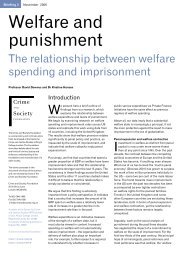PRISON SERVICE
PRISON SERVICE
PRISON SERVICE
- No tags were found...
Create successful ePaper yourself
Turn your PDF publications into a flip-book with our unique Google optimized e-Paper software.
deploy with sex offenders, and willbecome part of my recommendedreading list for those consideringentering this field of work.Phil Jarvis is Sex OffenderProgramme Manager forHertfordshire, Bedfordshire,Cambridgeshire and PeterboroughProbation Trusts.Book ReviewSex offenders and preventativedetention: Politics, policy andpracticeBy Bernadette McSherry andPatrick KeyzerPublisher: Federation press (2009)ISBN: 978-1-8628-7763-4(paperback)Price: £24.99 (paperback)This concise book compareslaws enacted in Australia, the UnitedStates of America and in Scotland tomanage high risk sex offenders. Thebook is authored by two AustralianLaw professors who specialise insocial and public policy. Despite itsshort length, this book manages topack a significant punch.The book opens by illustratinghow signal cases in each of the threecountries led to calls for theintroduction of new measures tomanage the risk presented by serioussex offenders. In the American andAustralian cases, the legislationallowed for indefinite detention to beordered post-sentence whilst inScotland the new orders were forlifelong supervision in the communityfollowing release and this wasimposed at the time of the originalsentence.The second chapter discussesthe practice of risk assessment. Thediscussion shows how a range offactors and different approaches canbe used in order to assess thelikelihood of an individualcommitting a serious offence in thefuture, however this also exposes thelimitations of the techniques whichare far from infallible. The authorstake this discussion further: theyexplore the ethical choices faced byprofessionals carrying out riskassessments in these circumstances;and how such decisions areessentially political rather than clinicalas they enact coercive state directedaction against identified groups.The third and fourth chaptersprovide a detailed examination of,respectively, the policy and practicalissues raised by the three differentschemes. This includes the humanrights risks posed by the differentapproaches, their effectiveness andtheir organisational efficiency. Thebook draws together these threadsand concludes that the Scottishpolicy provides the more positiveapproach. The authors argue thatthis is better in human rights termsbecause it takes place at the time ofsentencing and involves appropriateprofessional input. They alsoconclude that it is better organisedand has a more therapeuticapproach, attempting to reintegrateand support those who present a riskto live safely in the community aftertheir sentence.Discussing the management ofsex offenders is always intenselyemotive and for many, this provides abenchmark for the kind of criminaljustice system that should exist in acountry. As the authors of this bookpoint out, what might start as an‘exceptional’ measure quicklybecomes the norm and sets the tonefor the system as a whole. Given thechallenges of discussing themanagement of high risk sexoffenders, this book makes animportant contribution by conciselyand rationally evaluating differentinternational approaches to thisproblem.Jamie Bennett is Governor of HMPMorton Hall.Book ReviewAnti-social behaviour orders: Aculture of control?By Jane DonoghuePublisher: Palgrave Macmillan (2010)ISBN: 978-0-230-59444-9 (hardback)Price: £50.00 (hardback)Anti-social behaviour orderswere one of the flagship New Labourpolicies, providing a means throughwhich courts could issue ordersrequiring individuals to desist fromanti-social, but not necessarily criminalbehaviour. Although there has beennegative media coverage of someextreme examples of how the ordershave been used and the academiccommunity has been generallyhostile, the orders have met withpopular public approval. In this bookJane Donoghue, a lecturer in law atthe University of Reading reports thefindings of a study based on surveysand interviews with local authorityofficials and judges involved in antisocialbehaviour cases. Her essentialcase is that she sets herself apart fromthe majority of the academiccommunity and presents a positiveargument in support of the use ofASBOs.The book starts from the premisethat most academic criticism hasdescribed ASBOs as part of whatDavid Garland has described as a‘culture of control’ 1 , in other wordspunitive strategies, dominationstrategies and techniques ofsurveillance have been increasinglyused to replace more liberal welfareapproaches to crime and deviancethat sought to address the underlyingsocial problems. Donoghuechallenges this perception and arguesthat those at the margins of societyare not only those most likely toreceive ASBOs but are also those mostlikely to suffer the effects of anti-socialbehaviour. She therefore makes thecase that this is an approach that canbenefit the marginalised and sociallyexcluded and can form part of astrategy to address the underlying1. Garland, D. (2001) The culture of control: Crime and social order in contemporary society Oxford: Oxford University Press.Issue 192 Prison Service Journal63











